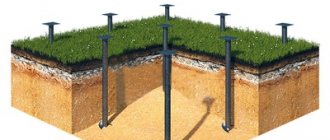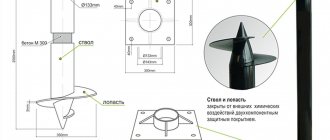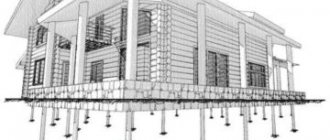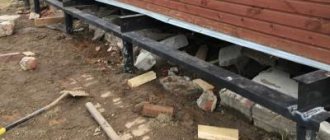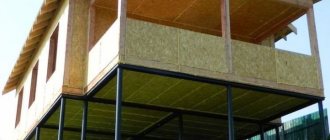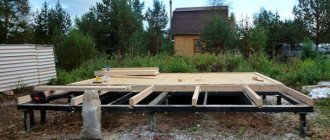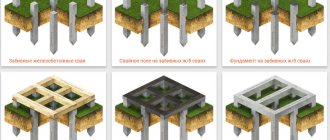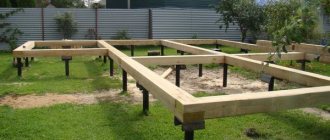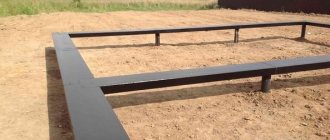The foundation of a house is the key to its reliability and durability. However, the desire to make a solid foundation leads to the fact that the cost of its arrangement takes up to 30% of the budget, which, of course, is quite expensive. The second most important expense incurred by the developer is the loss of time required to pour and strengthen a classic strip foundation.
However, modern technologies for building houses make it possible to optimize both monetary and financial costs through the use of pile foundations. In particular, foundations on screw piles have proven themselves to be excellent.
Screw piles - what are they?
Screw piles for foundationScrew piles for foundation are a type of piles, the penetration of which into the soil is carried out by combining screwing methods, as opposed to traditional driving. Screw piles are distinguished by the presence of blades on the trunk, which makes it possible to install them either with special equipment or manually.
Structural device of a screw pile
Structural elements of screw piles
The device of a screw pile is not complicated and consists of several parts:
– pipe (trunk). The upper part of the pipe has a technological hole for installing a rod that facilitates screwing in the pile;
– head. It is a metal platform that is fixed to the top of the barrel (pipe);
– blade. A spiral-shaped flat element located on the bottom of the pipe.
To protect against corrosion, the pile has an anti-corrosion coating. Material prepared for the website www.moydomik.net
Standards for screw piles
The production of screw piles is not regulated by GOST, but the key regulations are contained in:
- SP 50-102-2003;
- SNiP 2.02.03-85;
- (TU) 5264-006-05773342-2007 “Steel screw piles”.
Individual elements are regulated:
- metal quality:
– GOST 8732 – determines the quality of structural carbon steels;– GOST 19281 – determines the quality of low-alloy and alloy steels;
- quality of anti-corrosion coating (zinc layer):
– GOST 9.307-89 – determines galvanizing parameters for the hot-dip application method;– GOST 9.402-2004 – determines galvanizing parameters for the cold method.
- quality of blades:
– GOST 977-88 “Steel castings”.
- quality of welding seams - in accordance with relevant regulations.
At the same time, there is an international standard ICC AC358, which most manufacturers rely on.
Thus, the production of piles is carried out according to specifications (technical conditions), which are developed by a specific manufacturer.
Marking of screw piles
The designation must include the following technical information:
- steel quality;
- length (in m.p.);
- pile type (VSL - intended for seasonally frozen soils, VSLM - for permafrost soils);
- outer diameter of the pile shaft pipe (in mm);
- tip parameters: blade diameter (in mm), manufacturing method (cast or welded), steel grade.
The design of the foundation on screw piles is carried out according to SP 24.13330.2011.
When the groundwater level does not allow you to make a heavy foundation, and the weight of the structure of the house you are designing can be calculated quite accurately, as an option, the technology of installing a screw foundation may be quite suitable.
The foundation is undoubtedly the basis of any structure. In the construction market you may come across a large number of its varieties. At the base of the screw foundation there are either screw piles or supports. At their core, these are steel pipes. At their ends, specially shaped blades are welded on, which are designed not to loosen the soil, but, on the contrary, to create denser spaces between the turns of the soil . It is worth knowing that only two or three workers can handle and screw the piles without any problems. The quality and durability of the foundation (minimum 50 years) are undeniable. This is achieved by covering each pile, without exception, with a zinc thermodiffuse shell.
The screw foundation is excellent for almost all types of buildings. This includes houses made of timber, and buildings using technologies such as modular and frame, and houses made of aerated concrete, and cottages, bathhouses, and gazebos. What’s most interesting is that it can even be used when developing landscape design. The screw foundation has a large number of positive characteristics:
- the foundation can be used regardless of the quality of the soil;
- the cost of this type of foundation is much cheaper than standard types;
- a high degree of stability, as a result of which the foundation is not afraid of various unfavorable ground subsidences.
If housing construction has a time limit, then a screw foundation is an excellent solution. Another advantage is the fact that this type of foundation can be prepared in a couple of days; unfavorable weather conditions cannot become an obstacle. This foundation for your home makes it possible to evenly distribute the load-bearing loads. This means that in those places where the greatest loads are placed on the foundation, there is a need to bury a larger number of piles in the ground than usual. And that is not all. You should know that a screw foundation allows you to begin the construction of additional extensions in the future. This will help you increase your living space without difficulty. Also, this foundation is defined as earthquake-resistant. It can be used in the construction of houses in seismically hazardous areas.
Calculation of the number of screw piles
Screw piles are most often made of metal, but in rare cases you can also find plastic ones. They come in different lengths, have different diameters, and also differ in the shape of their blades. Screw piles made of plastic are used in the construction of lightweight structures. To build such piles manually, you need their components. And in order to screw them into the ground, you need either an electric machine or a lever rod. When preliminary calculating the number of screw piles you need in order to lay the foundation, there is a need to carefully study the design of the future facility. It must contain information about the number of floors in the house, a reference to the plan of the first floor, the number and location of openings for doors and windows, and diagrams of the load-bearing structures of the first floor floor. At the same time, stairs, stoves and fireplaces, if any, are indicated.
It is also advisable to know the geology of the area chosen for construction. Only after determining the volume of construction can you decide exactly what the number and diameter of the required screw piles will be. Prices for such piles vary from 800 to 12,000 rubles per pile. It all depends on their characteristics. In this regard, the cost for each object is calculated individually. For the safety and reliability of the operated object, all properties of the material are taken into account.
What are the pile diameters:
- 57 mm, 76 mm. Piles for lightweight structures, fences, fence posts, gas and water pipelines, children's play structures;
- 89 mm. Used for foundations for bathhouses, temporary structures, country houses, light metal structures, gazebos, piers, entrance lobbies, bridges;
- 108 mm. They are used for foundations for fairly heavy buildings: large houses and bathhouses made of timber or rounded logs:
- 133 mm. Suitable for foundations for heavy buildings: houses, bathhouses, hangars.
Most often in low-rise construction, piles with a diameter of 108 mm are used. with a blade diameter of 300 mm. On average, the bearing capacity of a pile with a diameter of 108 mm is from 4 to 6 tons, depending on the soil. After installation, the upper parts of the piles are cut to level and (most often) tied together with a beam or channel (according to the design), on which the frame of the house itself is subsequently laid directly.
Prices for the most common screw piles:
| № | Name | Diameter, mm. | Blade diameter, mm. | Length, mm. | Cost, rub. |
| 1 | SV-57 | 57 | 250 | 2000 | 1200 |
| 2 | SV-57 | 57 | 250 | 2500 | 1280 |
| 3 | SV-57 | 57 | 250 | 3000 | 1400 |
| 4 | SV-76 | 76 | 250 | 2000 | 1850 |
| 5 | SV-76 | 76 | 250 | 2500 | 1900 |
| 6 | SV-76 | 76 | 250 | 3000 | 2000 |
| 7 | SV-89 | 89 | 300 | 2000 | 1900 |
| 8 | SV-89 | 89 | 300 | 2500 | 1900 |
| 9 | SV-89 | 89 | 300 | 3000 | 2080 |
| 10 | SV-108 | 108 | 300 | 2000 | 2200 |
| 11 | SV-108 | 108 | 300 | 2500 | 2050 |
| 12 | SV-108 | 108 | 300 | 3000 | 2350 |
Principles of constructing a foundation on screw piles
The screw foundation has a set of important advantages in terms of its construction. When constructing such a foundation, there is no need for excavation work. Installation of this structure takes approximately 2 working days. At the same time, there is no need for a large amount of concrete and other materials. Stage-by-stage construction of a screw foundation. To begin with, it is necessary to mark along the entire border of the future building the places where the piles will be driven in the future.
After this, we proceed to tightening the piles. This can also be done manually using a special tool - a barbell. To avoid a crooked course of the column, you need to check its level after each pair of turns. Next, we begin to level the piles to one level. This can best be done using a rotating laser level, which creates an even horizontal line. If there are too long piles, then they should be trimmed using a grinder.
Then, you need to prepare a concrete solution based on M300 cement and pour it into the pipes. This is one of the most effective means of protection against corrosion and extends their service life. At the last phase of foundation construction, the metal frame is welded to the joints of the supports with internal circumferential seams. After this, the grillage needs to be painted in 2 layers of protective paint.
Video about the advantages of screw piles
Screw piles - area of application
The feasibility of using screw piles, in one case or another, depends on the type of soil. In particular, their installation is recommended when:
- the site has uneven terrain (presence of slopes);
- the region experiences significant low temperatures, causing significant freezing depth;
- There are weak soils on the site (peat, quicksand, clay, etc.). Dense soil is located deep;
- construction is carried out in hard-to-reach areas and the delivery of building materials, as well as the removal of soil from the pit, is complicated;
- groundwater is located too close to the soil surface;
- impossibility of constructing a pit on the site (no passage, buildings built nearby, etc.);
- Temporary construction is expected (for example, attractions, pavilions, tents).
Often, a pile-screw foundation is chosen by those developers who strive to combine construction and the natural landscape as organically as possible.
According to SP 24.13330.2011, a screw foundation can only be used in low-rise construction, provided that lightweight materials are used. The use of screw piles for small houses, cottages, log houses, garages, gazebos, terraces, fences, etc. is justified.
Screwing in screw piles and leveling them
The process of installing piles does not depend on the type of tips, soil, or number of blades. The work consists of several stages:
- Drilling of guide pits is carried out using a hand or motorized drill. The depth should be at least 0.5-0.7 meters, the width should be slightly larger than the width of the support with blades.
- When drilling manually, the pile is placed in a pit and a crowbar is inserted into the hole located in the upper part of the support. Two workers begin to move in a circle to screw in the pile to the required depth.
- After installing all the supports, their upper parts are cut to the same level. For marking you need a building level, for trimming you need a grinder.
The pile installation process consists of several stages.
Characteristics of screw piles - types, types, sizes
Due to the fact that screw piles are manufactured according to specifications and are in demand for buildings for various purposes, on different types of soil, several varieties are presented on the market, and a generalized classification is given in the table:
| No. | Classification feature | Detailing |
| 1 | Soil feature | – seasonally frozen soil; – permafrost soil. |
| 2 | Tip type | – cast; – welded. |
| 3 | Number of blades | – single-blade; – multi-lobed. |
| 4 | Blade size | – broad-bladed; – narrow-bladed. |
| 5 | Pipe size(mm) | – length – 3-12 m. – diameter – 89-325 mm. – wall thickness – 8-12 mm. |
Technical characteristics of each variety
According to soil characteristics:
- seasonal freezing soil (SFS). In this case, ordinary piles are used, which are screwed into the soil without preliminary drilling. Visually, such piles are distinguished by the classic type of blade and hermetically welded pile cone. The installation site of the pile is filled with cement-sand mortar;
- permafrost soil (PFSM). Screwing into the soil requires preliminary drilling of the soil. Visually, they are distinguished by fine rifling along the entire length of the barrel. The installation site of the pile is filled with sand.
By type of pile tip:
The purpose of the tip is to make the process of screwing the pile as easy as possible.
- cast tips for screw piles. They have a significant cost and are justified in the presence of very dense and/or permafrost soils. The cast tip is capable of screwing the pile into the most difficult soil without destruction without deformation;
- welded tips for screw piles. A cheaper option, however, has a weak point in the form of a weld. This type of pile is in demand by developers who screw the pile by hand. Because there is a risk of deforming the pile when twisting by machine. In this case, the pile is twisted to the stop (obstacle), and not to the calculated depth.
By number of blades:
- single-blade. Piles with one blade can only be used in dense soils, in the case where the tip of the pile will rest against a solid base;
- multi-lobed. The number of blades can be from one to six. The weaker the soil, the more blades the pile should have, this is due to the fact that multi-bladed piles are more resistant to pushing/pushing and horizontal loads.
Types of screw piles (single-blade, bi-blade and multi-blade)
By blade size:
- broad-bladed. Blades are considered wide if their diameter exceeds the diameter of the pipe by one and a half times or more. According to individual specifications, it can be in the range from 200 to 350 mm. The significant diameter of screw piles allows them to maintain a stable position in soft soils. Deviation within +/- 9 mm;
- narrow-bladed. Designed for frozen and dense soils. Due to the fact that the diameter of the screw pile blade is insignificant, it is easier to screw it into the ground.
The metal thickness for the blades varies from 9.5 to 12.5 mm.
By pipe size:
Pipe dimensions are a collective parameter, it includes:
- pipe (barrel) diameter – 159-325 mm. Among the most popular are 89, 108 and 133 mm;
- pipe length – 3-12 m.p. Deviation within +/- 50 mm;
- metal thickness – 8-12 mm. Deviation within +/- 2 mm.
Thickening the walls, in turn, increases the cost of the screw pile, but reducing the thickness reduces its performance characteristics. The international standard ICC AC358 regulates the wall thickness of the pile shaft to be 8 mm. for use in neutral soil, and 9.5 mm for chemically active soil.
Note. There are piles on the market with a wall thickness of 3-4 mm.
The use of standard sizes of screw piles depending on the purpose of the structure is presented in the table:
Classification of piles by size
First of all, piles are distinguished by the diameter of the pipe, which acts as the body of the pile. Typically, seamless pipes with a diameter of 57 to 133 mm and above, with a wall thickness of 4 mm, are used.
The most common pipe sizes in combination with the wall:
- 57x4
- 73x4
- 76x4-5
- 89x4-5
- 108x4-6
- 133x4-6
In addition to the cross-section of pipes, piles can vary in standard length. Typical piles for the construction of large structures are usually made with a length of about 2.5-3 meters. This is usually enough for the pile to go into the ground to a depth below the freezing point of the soil. In Russia, this parameter varies from 1.5 to 2.5 meters. In this case, the pile protrudes 50-70 cm above the ground surface and is cut to the level of the foundation plane, taking into account a possible slight slope in the area.
Shorter piles are produced for the installation of lightweight structures, as well as for the installation of individual, relatively lightweight supports - in the construction of fences, sheds, etc. The standard length of short piles is from 1.5 to 2 meters.
Screw piles - pros and cons
Advantages of screw piles:
- relatively low price of screw piles;
- the ability to carry out work in close proximity to other buildings, communications or plantings;
- the ability to install the pile yourself;
- significant installation speed;
- lack of excavation work;
- absence of vibration and noise when driving the pile;
- Possibility of installation in areas with uneven terrain;
- reuse is allowed.
Note that the listed advantages are typical for piles manufactured industrially.
Disadvantages of screw piles:
- impossibility of use on rocky soils, due to the risk of deformation of the blades or trunk;
- ban on use in seismically active areas;
- inappropriate for use in chemically active soils. Significant metal processing is required to improve its performance characteristics;
- inappropriate for use on soils with weak lateral support.
Quick installation of screw piles is one of the undoubted advantages of this type of foundation piles. In this case, the customer has the opportunity to choose one of three installation technologies. In particular:
- mechanical method. Involves the use of auxiliary mechanisms (winches, etc.);
- manual method. Installation will require several people and a lever. However, the thicker the trunk and the larger the diameter of the pile blades, the more difficult it will be to screw it into the ground. Therefore, the use of the method is justified only for small piles;
- hydraulic method. Note that the use of special equipment allows you to screw the pile into the ground at a given angle (up to 40°).
Calculation of screw piles for the foundation
The installation of screw piles is preceded by calculation of the required number, screwing depth and determination of the distance.
In particular, the calculation of screw piles is carried out according to SNiP 2.02.03-85.
The number of piles in the foundation and their dimensions should be determined based on the condition of maximum use of the strength of the pile material and foundation soils at the design load allowed on the pile. Therefore, in order to determine how many screw piles are needed for a house (6x6, 8x8), you should have complete information about the specified parameters. They also determine the optimal distance between screw piles during installation.
Requirements for the quality of piles
Products must meet the following requirements:
- For the manufacture of screw piles, new steel that is not subject to corrosive changes should be used.
- Welds on the rod are not allowed.
- The blades must have a symmetrical shape of the established dimensions (diameter from 30 cm, thickness - at least 0.5 cm).
- Considering that screw piles are screwed into the soil with considerable force, especially in areas with compacted or rocky soil, special attention should be paid to the strength of the rod.
- All elements of a pile screw foundation must be pre-cleaned with a sandblaster and also treated with special means to prevent the development of corrosion processes. Careful treatment of metal elements against corrosion will help increase the strength and reliability of the constructed foundation as a whole.
Service life of screw piles
Among the factors that influence the service life of screw piles are:
- steel thickness of the screw pile shaft;
- presence and type of anti-corrosion coating. When planning to buy screw piles, you should pay attention to the presence, type and thickness of the anti-corrosion coating, the purpose of which is to protect the pile in the soil. Its presence is especially important when installing piles in chemically active soil. The coating used is galvanizing or polymer coating. The thicker the coating layer, the longer it will protect the metal from corrosion.
- chemical activity of the soil at the site of pile installation. For example, sand or dry shale has the lowest chemical reactivity. In these soils, a pile not covered with a protective composition will last more than 300 years, and with protection up to 800 (calculation data depends, among other things, on the type of coating). On the contrary, in soils with high chemical activity (peat, sea soil, silt), the service life of the pile is about 30 years. If covered, it can be extended up to 75 years.
Types of piles, advantages and disadvantages
Due to the fairly simple design, there are not many types of screw piles. In most cases, there are three main types of screw piles:
- cast _ The tip is manufactured in exact accordance with the existing model as a single unit. They have the greatest strength;
- combined . It is assumed that there are two main parts - a blade and a cone. Modern technologies make it possible to produce such piles that can withstand heavy loads (up to 50 tons);
- welded _ They are made as follows. Blades are welded onto the pointed lower end of the pile. For high-quality and reliable execution, the process must be carried out using plasma cutting.
Advantages
The use of foundations based on screw piles has a number of undoubted advantages:
- economy . Foundations on screw piles, with strength comparable to strip and prefabricated reinforced concrete blocks, are much cheaper to produce. This is achieved by the fact that the work is completed quickly, there is no need to perform labor-intensive excavation work and waste removal;
- ability to perform work in difficult conditions . Construction of foundations from screw piles is possible on any terrain, in wooded areas without the need to uproot tree roots, in hard-to-reach places with no access roads, since bulky equipment is not needed. In addition, a pile-screw foundation can be used on soft soils;
- no noticeable shrinkage . The design features of the piles imply that during the process of their immersion (screwing), additional compaction of the soil occurs automatically. Therefore, shrinkage of foundations is almost completely absent, which makes it possible to immediately begin subsequent work;
- Possibility of use in extensions . The absence of dynamic loads on the soil, already noted above, will make it possible to install a pile-screw foundation in the immediate vicinity of already constructed buildings and structures. An additional advantage is that due to the lack of large equipment, as a rule, the already cultivated and landscaped area around does not suffer;
- Possibility of performing work at any time of the year;
- long service life (more than 100 years), achieved by reliable design.
Flaws
The main disadvantage of using screw piles is related to the material from which they are made. Metal is extremely prone to corrosion , so when purchasing ready-made piles or materials for making them yourself, you need to pay attention to the quality of the metal and its processing. The best option is a new metal pipe at least 4 mm thick, sandblasted and then applied with an anti-corrosion coating. For blades, the metal thickness must be at least 5 mm.
Another disadvantage of screw piles is the difficulty of using them in soils with a high content of large stones. This especially applies to welded and combined varieties.
Many customers consider the lack of a basement, which is not provided for by the design of a pile-screw foundation, to be a disadvantage.
Which screw piles to choose for the foundation
When choosing screw piles, it would be correct to pay attention to:
- diameter and wall thickness of the pipe. It is advisable to choose new screw piles. In the case of used piles (second-hand), there is a risk of getting a pile with internal corrosion and incorrect geometry. In addition, difficulties will arise with determining its load-bearing capacity, and therefore the total number and installation pitch of screw piles;
- accuracy of the bottom of the pile. It should be in the shape of a cone. Deviation is fraught with screwing the pile at an angle, which affects its load-bearing capacity;
- number of blade screws;
- angle of attack of the blade (determines the load-bearing capacity of the pile and ease of screwing);
- quality of the weld seam (for welded screw piles);
- the presence of a protective coating.
What is a screw support
This is a pipe, usually steel. On one side it is equipped with a sharp tip and a blade in the shape of a spiral. This is such a large self-tapping screw for soil. This blade allows you to significantly reduce the pressure on the ground, and also prevents the pile from being pulled out during the period of soil heaving. So, a screw or a screw tip is the main element that determines the reliability of such bases.
In the construction of low-rise private houses, piles measuring 108 mm/300 mm are used, where the first number is the diameter of the trunk, and the second is the size of the blade. Such a metal support can have a load-bearing capacity of 2 to 9 tons under suitable soil conditions.
It must be said that a foundation using this technology is perfectly maintained in any soil and very effectively protects the building from the slightest deformation. The special arrangement and design of the blade allows this support to withstand various processes very actively.
Screw support
The blade works in such a way that during installation the soil is not loosened, but compacted even more. At the end of installation of the base, fastening occurs using wood or concrete. The popularity of this technology is justified. Many have already been able to appreciate all the advantages of such a foundation. And different soils have their own support.
